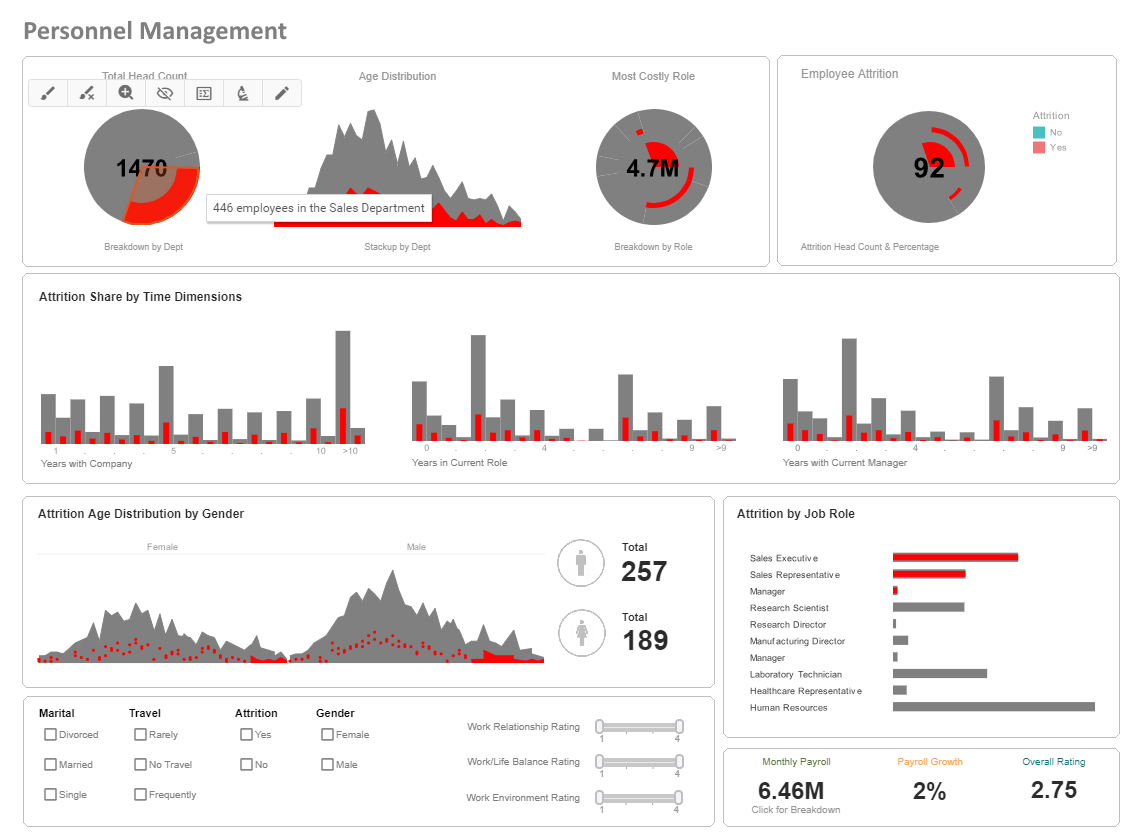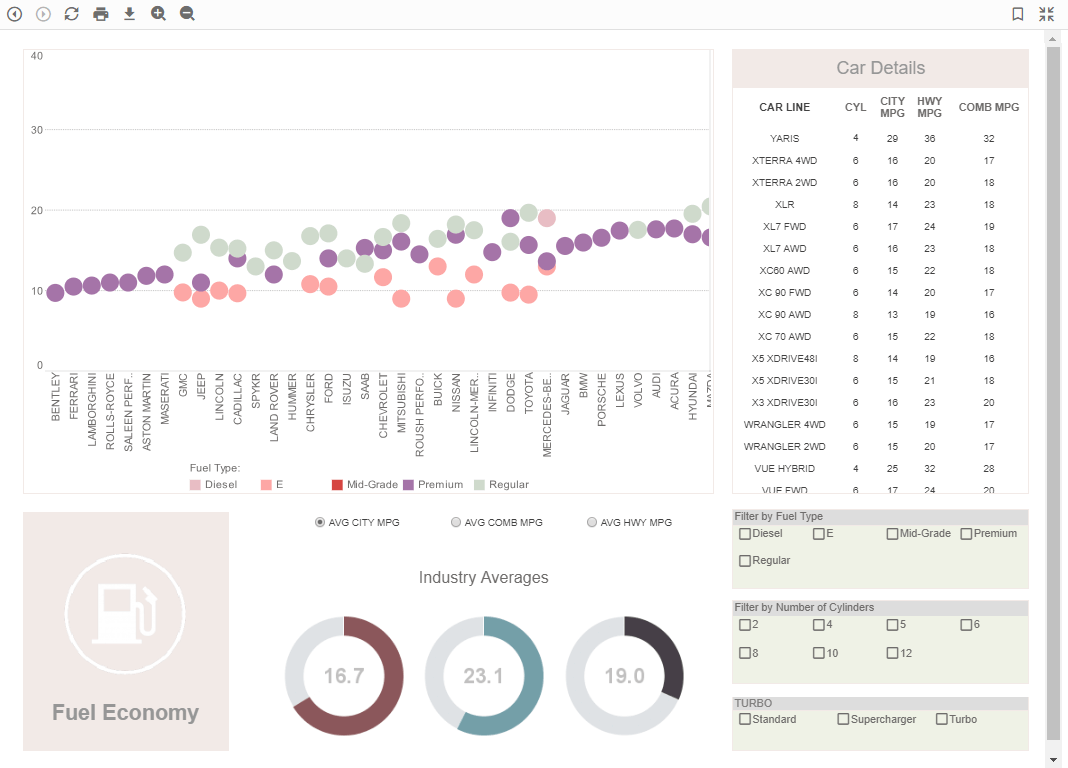Good Report Designer
Since 1996 InetSoft has been offering reporting software applications that are flexible and powerful, serving over 5,000 enterprises and solution providers worldwide. Reporting has always been tightly coupled to everyday business activities.
As a result, reporting requirements tend to change very often. Traditionally, when such changes occurred, you were forced to rely on developers or IT staff to revise your reports to meet the new requirements.
Not only does our software, Style Intelligence enable the creation of production reports and supports end-user driven ad hoc reporting, it also enables writing back to databases. So now you can quickly build reports, based from the web, that can both visualize and update data. Build reports from almost any data source and provide controlled forms for updating or inputting information.
| #1 Ranking: Read how InetSoft was rated #1 for user adoption in G2's user survey-based index | Read More |
The InetSoft Difference
InetSoft believes the solution to this problem is user empowerment. Instead of requiring you to communicate your needs to developers and then iterate over successive changes, Style Intelligence gives you direct access to powerful reporting software tools that allow you to rapidly and easily design your reports yourself.
Other BI tools have previously attempted to provide functional reporting. However, these tools have not reached a significant level of prevalence due to the following factors:
- Business reports are complex. Report writers are often large applications that have a steep learning curve.
- Business information is complex. Report writers often require that you understand the database query language and know how the data is stored. Style Intelligence™ solves both these problems. It addresses the first with an Ad Hoc tool that is lightweight, web-based, and easy to use. It addresses the second by automatically handling all the technical details of accessing data.

Create New Reports with the Ad Hoc Tool
Our reporting tools fix the aforementioned problems by allowing you to create reports from scratch. Some key ad hoc reporting features are:
- Intuitive, 100% Web, zero-client access from portal
- Wizard-guided report creation and free-form editing
- Aggregate, grouping, filtering
- Report layout and presentation element library
- Security restrictions automatically applied
Enterprise Reporting
Manipulate and present raw data with a sophisticated layout and flow for your enterprise. Style Intelligence™ embeds business logic using JavaScript and uses high-fidelity output in multiple formats. Reporting to your enterprise is easy, agile and robust. Some key features are:
- Production reports with embedded business logic and parameterization
- Interactive reports and in-report exploration
- Secure enterprise level development and deployment
- Bursting and scheduled reports



Interactive Report Viewing
Style Intelligence™ is not desktop confined. You can access all of your data via the web; all compatible with your existing IT configuration.
- Report element context menu
- Real-time viewing or queued reports
- Mobile reporting accessible from Web-enabled devices including Android-based tablets, smartphones, iPads, and iPhones
- All popular Web browsers supported via HTML5- e.g., Chrome, Internet Explorer, Firefox, Safari
- Zero-client, security controlled Web portal
- In-report sorting, filtering, hide/unhide
- Drilldown from any report element to another report or URL
- Parameterization in cascade and staging modes
- Summary/detail toggling displays
- Dropdown lists, text fields and other form controls
- Export to Excel, PowerPoint, PDF, RTF-Word, CSV, PostScript, Text, and SVG
- Email, server-based printing, and client-based printing
- Archived reports with in-report exploration
What KPIs and Metrics Would a Good Designer Put on the Dashboard for Seafood Processing Company?
For a seafood processing company, designing a dashboard to track key performance indicators (KPIs) and metrics is essential for ensuring efficiency, quality, safety, and profitability. A good designer would need to balance operational, financial, and compliance-related metrics while providing actionable insights that improve the processing workflow. Here's a breakdown of the KPIs and metrics that would be valuable for such a company:
1. Production and Efficiency Metrics
- Throughput Rate: Measures the amount of seafood processed per hour or shift. This is a key indicator of productivity.
- Yield Percentage: Tracks the ratio of finished products to raw materials. This metric indicates how much waste is being generated and how efficiently the seafood is being processed.
- Machine Downtime: Monitoring equipment downtime helps identify inefficiencies in the processing line and points to areas that may need maintenance or process improvement.
- Units Processed per Labor Hour: This metric measures labor efficiency by tracking the amount of seafood processed relative to labor input.
- Cycle Time: Tracks the total time taken to process seafood from the raw product entering the facility to the final product ready for shipment. Lower cycle times generally indicate higher efficiency.
2. Quality Control and Safety Metrics
- Product Defect Rate: Monitors the percentage of seafood products that fail to meet quality standards, helping to identify areas in the process that may need adjustment.
- Temperature Control Compliance: Ensures that seafood is being processed and stored within optimal temperature ranges to maintain freshness and prevent spoilage.
- Foreign Matter Contamination Rate: Tracks the frequency of foreign matter found in processed seafood, ensuring food safety and compliance with regulations.
- Product Recall Rate: Measures the frequency and causes of recalls, providing insight into how well quality control processes are working.
- Customer Complaints: Tracks customer feedback related to quality issues. This can help highlight trends and root causes of recurring problems.
3. Waste and Sustainability Metrics
- Waste Ratio: Measures the amount of waste generated during processing relative to the amount of raw seafood processed. Tracking waste can lead to cost savings and more sustainable operations.
- Water Usage per Unit of Production: Since seafood processing involves significant water usage, this metric helps monitor water efficiency and identify opportunities for conservation.
- Energy Consumption: Tracks the amount of energy used in relation to production output. Reducing energy consumption can improve both environmental sustainability and operational costs.
- Byproduct Utilization Rate: Measures how well the company is using byproducts (such as fish bones or shells) for other purposes, such as producing fishmeal or other secondary products.
4. Supply Chain and Inventory Metrics
- Raw Material Inventory Levels: Monitors the quantity of raw seafood available for processing, ensuring that there are enough materials to meet demand without overstocking, which can lead to spoilage.
- Days Inventory Outstanding (DIO): Tracks the average number of days that seafood products remain in inventory before being sold or processed. This metric is especially important for perishable goods like seafood.
- Supplier On-Time Delivery Rate: Measures the reliability of suppliers in delivering raw materials on time, reducing the risk of production delays.
- Lead Time for Raw Materials: Tracks how long it takes for suppliers to deliver raw materials after placing an order, helping to optimize ordering schedules and reduce downtime.
5. Financial Metrics
- Cost per Unit of Production: Measures the total cost to process each unit of seafood, factoring in labor, equipment, energy, and other operational expenses.
- Profit Margin per Product Line: Monitors profitability across different product lines, such as fresh seafood, frozen seafood, or value-added products (like pre-cooked meals).
- Sales per Processing Line: Tracks revenue generated by each processing line or product type, helping to identify the most profitable areas of the business.
- Return on Assets (ROA): Measures how efficiently the company uses its assets (such as processing equipment and storage facilities) to generate profit.
- Cost of Goods Sold (COGS): Tracks the direct costs involved in seafood processing, such as raw material costs, labor, and packaging. Monitoring COGS helps maintain profitability by identifying areas to reduce expenses.
6. Compliance and Regulatory Metrics
- HACCP Compliance Rate: Measures how well the company complies with Hazard Analysis Critical Control Points (HACCP) requirements for food safety, a key regulatory standard in the seafood industry.
- Audit Pass Rate: Tracks the company's success rate in passing internal and external food safety audits, which may be conducted by regulators or industry bodies.
- Employee Training Completion Rate: Ensures that all employees working in seafood processing are up-to-date on required food safety, hygiene, and workplace safety training.
- Incident Rate (OSHA): Monitors workplace accidents and safety incidents, which are critical for maintaining a safe work environment in seafood processing facilities.
- Environmental Compliance Rate: Tracks adherence to environmental regulations, such as wastewater disposal or emissions, ensuring that the company is operating within legal limits.
7. Workforce and Labor Metrics
- Employee Productivity: Measures how much seafood is processed per employee, providing insight into labor efficiency.
- Labor Cost per Unit of Production: Tracks labor costs as a percentage of total processing costs, helping the company to optimize workforce management.
- Employee Turnover Rate: Measures the rate at which employees leave the company, an important metric for understanding workforce stability and maintaining operational efficiency.
- Worker Absenteeism: Tracks how often employees are absent, which can impact production capacity and lead to delays in the processing line.
- Workplace Safety Incidents: Monitors the number of accidents or near-misses in the processing facility, helping to identify areas for improvement in safety protocols.
8. Market and Customer-Related Metrics
- Order Fulfillment Rate: Tracks the percentage of customer orders that are completed on time and without issues, a key metric for customer satisfaction.
- On-Time Delivery Rate: Measures the efficiency of delivering processed seafood to clients or retailers on schedule, ensuring product freshness.
- Customer Satisfaction Score: Gathers feedback from clients on product quality, delivery timeliness, and overall service.
- Market Share by Product Type: Monitors how much of the market the company controls for different types of seafood products, helping the company track its competitive position.
- Sales Forecast Accuracy: Tracks how well the company's sales forecasts align with actual sales figures, helping improve future predictions and inventory management.


